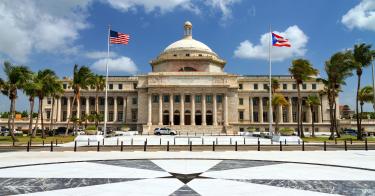Six-year-old Jacob dreads going to school where he often encounters violent bullies. Even though Jacob’s mother, Jennifer Gonzalez Muoz, repeatedly addressed the problem with school officials, the violence persists.
As the Institute for Justice details, the family’s low income means that Jacob is trapped in a toxic environment by their ZIP code where his speech disability is untreated and officials permit bullying. Unfortunately, Jacob’s story is all too common for many Puerto Rican children.
However, the territorial government, with the support of Gov. Ricardo Russello and Education Secretary Julia Keleher, is trying to change that by empowering families with education choice. The problems plaguing the Puerto Rican education system were exacerbated by Hurricane Maria’s devastation last year. This year, charter schools became available for the first time, and a pilot school-voucher option will be available beginning next school year.
The school voucher program is Jacob’s chance to escape an unhealthy environment and attend a school that can address his learning needs. The pilot program is geared to help young people victimized by student bullying or sexual harassment to find a safe and effective school.
Many Puerto Ricans cannot afford to move to find better schools. And even worse, Puerto Rican children aren’t learning.
According to the National Assessment of Educational Progress (NAEP), Puerto Rican students score lower in mathematics than students in the Bureau of Indian Affairs schools — which were deemed the “worst schools in America.”
Incredibly, Puerto Rican eighth graders trail the national average by nearly seven grade levels.
Puerto Rico’s abysmal academic achievement outcomes show that the government school system isn’t meeting the needs of children. So, Puerto Rico’s foray into school choice is an exciting step in the right direction for families.
The president of EdChoice, Robert Enlow, noted how Puerto Rico’s education reforms address parents’ major concerns. “Parents want a safe, moral, quality environment. They don’t care about school type,” he noted. Children need to “get in where they fit in,” he continued. Puerto Rico’s charter schools and voucher options will give families the opportunity to do just that.
The positive effects of Puerto Rico’s education reforms are taking shape in Proyecto Vimenti, the territory’s first charter school. Proyecto Vimenti’s curriculum is modeled after one of Puerto Rico’s best private schools and aims to “break the express generational cycle of poverty.”
Andrew Ujifusa from Education Week reports that Proyecto Vimenti’s reforms have had an immediate impact on the community. The school’s health screenings, for example, found that more than half of the students needed glasses. Now they have them — and the ability to see the writing on classroom chalkboards.
Mr. Ujifusa notes that “the average annual salary of a person living in the area served by the charter school is $5,000.” In this regard, the Proyecto Vimenti community is not unique. More than 40 percent of the island’s population lives below the federal poverty line. The pervasive poverty, coupled with the government’s crushing $49 billion dollar debt — greater than the top five municipal bankruptcies including Detroit — has lent a sense of urgency to the education reform movement.
As U.S. Assistant Secretary for Elementary and Secondary Education Frank Brogan remarked, Puerto Rico “will in its own way be a laboratory of observation for people all over the country who are going to look to Puerto Rico as a beacon of example of what change can bring.”
As Puerto Ricans rebuild communities in Maria’s wake, they are also redesigning a failed education system. The new system seeks to leverage the innovation and quality created through private school choice options and charter schools and to empower families — rather than government officials — to make decisions about their children’s schooling.
School choice is opportunity for all children to tailor education to their needs. Puerto Rico now joins the 29 states and D.C. that embrace education choice to help children find the best educational fit for them.
This piece originally appeared in The Washington Times



